Insights-led Customer Engagement Statistics To Bookmark
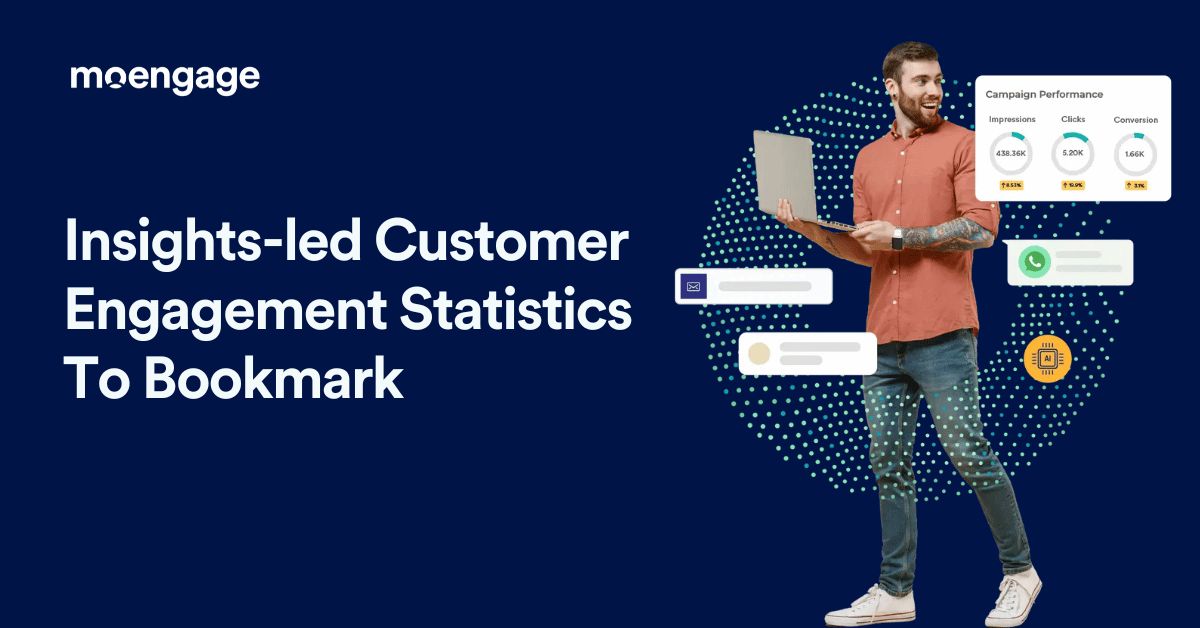
Reading Time: 10 minutes
“In five years, marketers will be prized for their insight on customers, not their creativity,” said Brian Massey in 2013.
It has been more than five years, and this statement couldn’t be more relevant today. Data has always been the be-all and end-all for marketers. One reason can be — marketers focus on data analytics to monitor customers’ app activity, measure campaign performance, and optimize campaigns accordingly.
Data helps you know customers’ preferred products, interests, locations, and more.
But is that enough? NO.
The Current Customer Engagement Statistics
We have 5.32 billion mobile phone customers and more than 4 billion consumers using online social media channels.
Today’s customer is exposed to many mobile devices and online channels. They can easily find their preferred products in a competitive market. This directly means there’s no brand trust and zero loyalty. Brands need to understand that loyal customers prefer hyper-personalized experiences. To build such an experience, brands must successfully engage customers across multiple channels while being relevant across the purchase journey.
Data might help us understand what’s working and not in a customer’s journey. However, it fails to predict our customer’s actions or their changing buying behavior on a human level. Thereby negating the chance of creating hyper-personalized customer interactions.
Data is Good, But Insights are Better
Using data, marketers are creating campaign-centric engagement strategies. This strategy lacks proactiveness and personalization, thus not building a unique customer experience.
This data-driven approach to engaging your customers is not accommodating customers’ unique needs either. Today’s customers expect brands to be more farsighted and interact based on app/website behavior and purchase decisions.
Insights can only solve these gaps in the data. It acts as the bridge between two or more data points and helps you connect them more meaningfully. Thus creating a customer-centric engagement. Yes, data is good – but insights are better.
It is time that you, marketers, move to a customer-centric approach; and adopt an insights-led engagement.
You’re relentlessly focusing on creating tailored engagements for our customers, and the one power move that will give the brands the edge is Insights.
Driving a Smooth Customer Journey
Insights-led engagement is the way forward as it helps bring back the customer in customer engagement. This approach allows marketers to drive a seamless journey while engaging customers at different purchase stages. This approach enables marketers to create a continuous loop where customer behavior, preferences, affinity, and patterns are analyzed to produce numerous real-time insights.
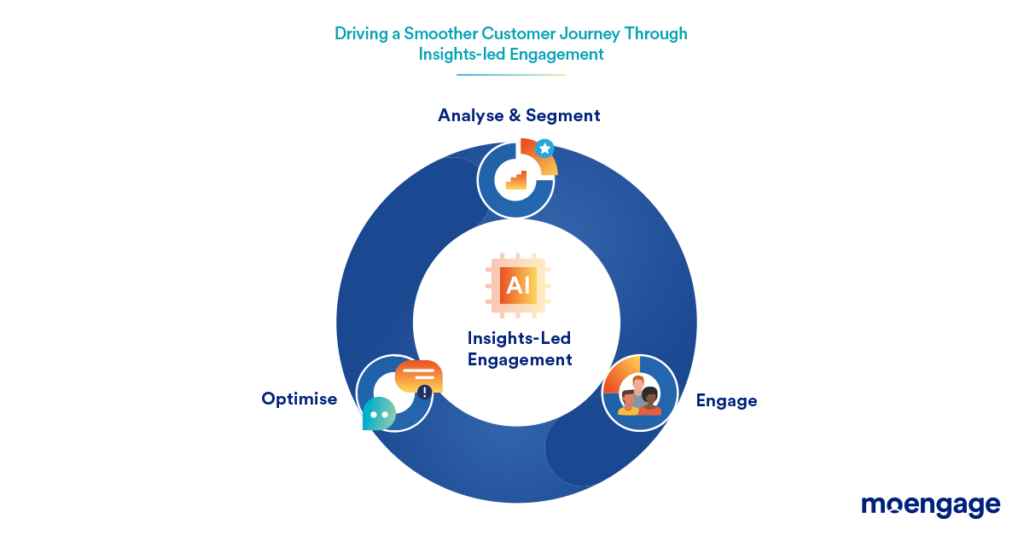
These insights cover three core aspects — customer, journey, and campaign.
Brands usually follow a typical plan -> run -> analyze -> course-correct. But they need to re-look at the engagement approach and move to a more customer-centric one. That’s why the insights-led engagement approach as it considers the overall customer experience.
To ensure this is the right path, we commissioned a report that helped us understand the pressing need to adopt an insights-led engagement and its impact on customer engagement statistics and business growth.
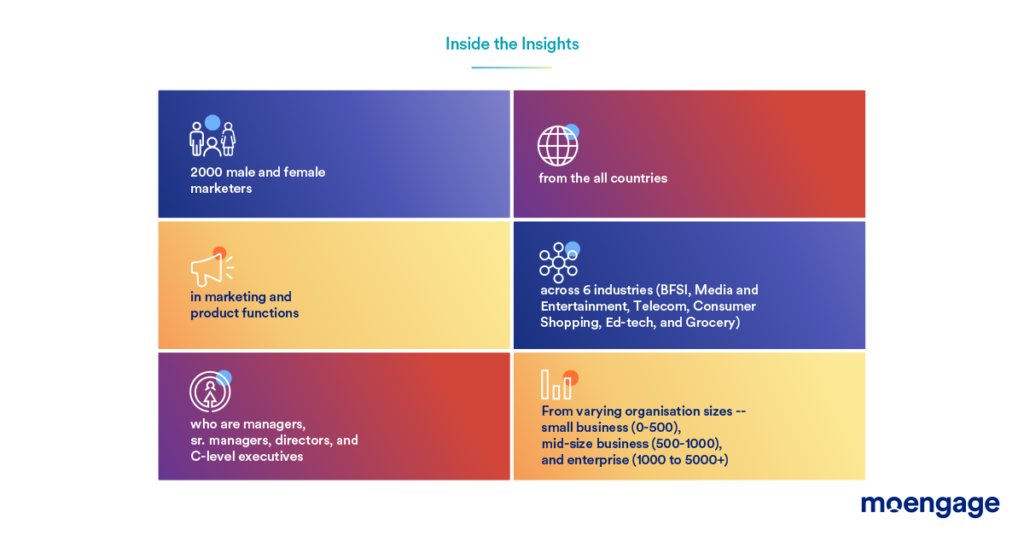
1. Current Customer Engagement Trends and Landscape
We now know marketers want to dive deeper when understanding customers to have a competitive advantage. However, the chances of this happening from their current customer engagement tech stack might be holding them back.
Even before we understand the type of insights marketers are currently considering when mapping their customer journey, we want to know the following:
- What platforms do they have in their marketing tech stack?
- What is their top priority platform?
- What is their ultimate engagement challenge?
Let’s dive a little deeper and see what our survey found.
1.1 Current Marketing Tech Stack
Our first objective was to understand the customer engagement statistics from a marketing tech stack point of view.
The survey disclosed that 24.6% of marketers have a customer relationship management (CRM) platform as their primary customer engagement tech stack. Multichannel customer engagement platforms (CEP) and customer data platforms (CDP) closely follow with 20.6%.
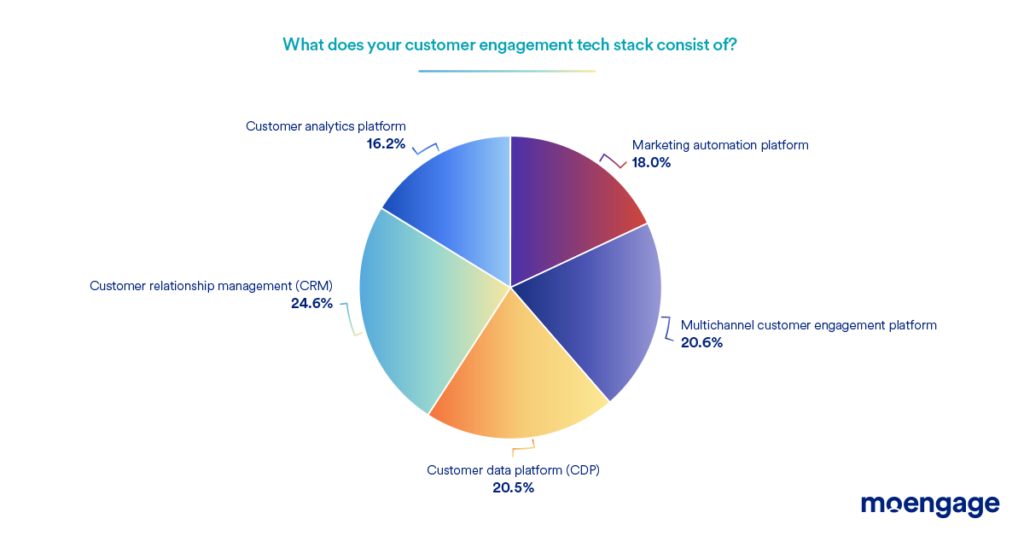
CRM becomes the top marketing tech stack platform
Even when we considered the data based on filters such as industry verticals, organization roles, and organization size — we discovered the same answer — CRM is marketing executives’ go-to tech stack. However, Media and Entertainment is one step ahead by employing a multichannel CEP as their core marketing tech stack, with others supporting it.
When we examined the data from various regional perspectives, we found that CRM is the most utilized tech stack for five regional markets.
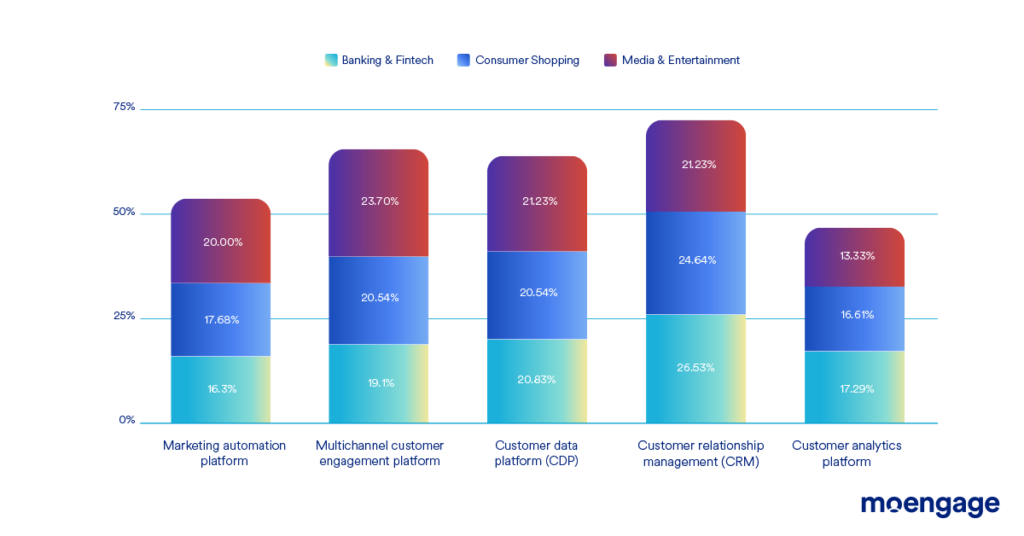
Surprise, surprise! CRM seems the most preferred platform for the marketing folks; however, it is a platform like multichannel CEP these folks should employ.
Choosing a multichannel CEP instead of CRM
It is understood that a platform like CRM provides data while analyzing customer interactions to enhance customer support and drive better sales. The platform offers a holistic understanding of a customer, but that is not enough. That’s where an integrated CEP goes a step further. A CEP will help you create a 360-degree unified profile of your customer that will help you create omnichannel personalized experiences.
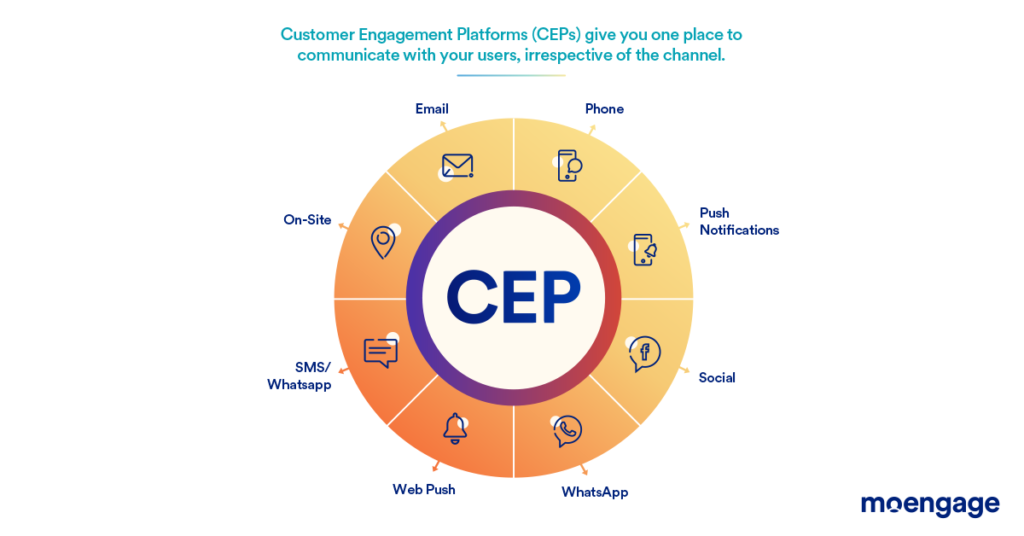
1.2 Top Challenges in your Customer Engagement Strategies
After getting the pulse on the most utilized platforms, our next concern was their top engagement challenges. And surprise, surprise.
Most marketers say lack of real-time analytics is their top challenge.
34.5% of marketers disclosed that the lack of real-time analytics in their current marketing tech stack is a problem. Without data analysis, they can’t create relevant, hyper-personalized journeys affecting the positive customer experience.
19.9% of marketers disclosed that a lack of understanding most effective marketing channels and the best time to send is their second problem.
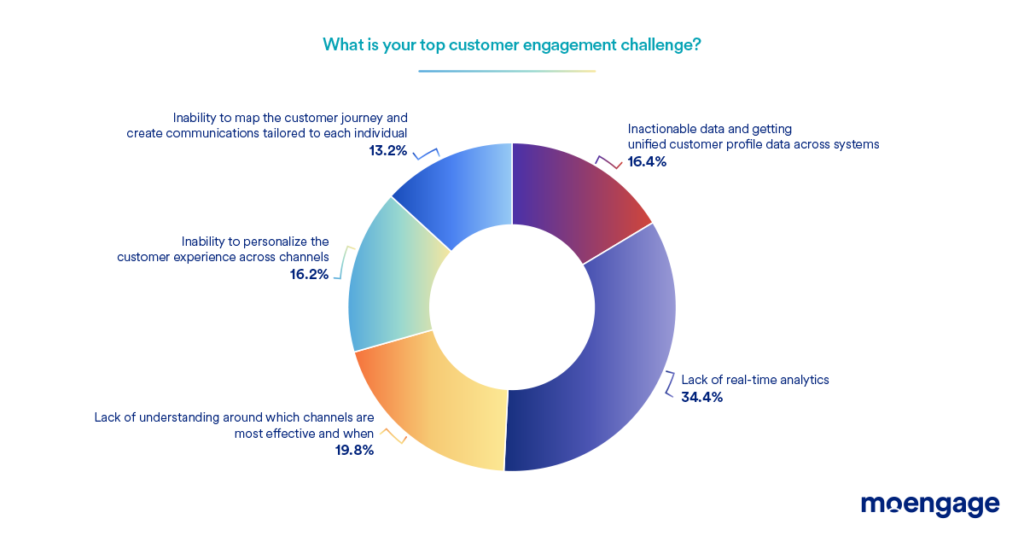
Marketers need to analyze beyond primary data.
The lack of real-time analytics is the top problem. But the crucial point to note is when building brand loyalty and making customers happy, the two concerns that marketers should focus on but are not is:
- Inability to personalize the customer’s experience across channels, and
- Inactionable data and get unified customer profile data across systems.
More customers expect brands to understand their buying patterns and provide personalized experiences accordingly. But with no means of unifying the customer data to make it actionable or using this actionable data to create customized experiences, how can brands fulfill customers’ expectations?
It goes back to the same argument — marketers need more actionable information on their customers to provide a customer experience that will be key to their marketing success. But unfortunately, for most, their existing marketing tech stack is not allowing them to dive deeper into the data.
2. Inside the Insights
Moving ahead — now that you know marketers’ challenges with their existing marketing tech stack, the next thing to understand is the type of insights they observe. To create an insights-led customer engagement strategy, you need to understand insights on three levels: customer, their journey, and the online campaigns.
2.1 Insights on Customers
Let’s begin with understanding what customer insights you observe regarding your day-to-day engagement statistics.
Marketers want to know customers’ interests, choices, and affinities.
23.6% of marketers observe interest, choice, and affinity, which is basically to understand the most purchased product or viewed content. This is followed by the primary demographic data, such as name and location, with 22.2%.
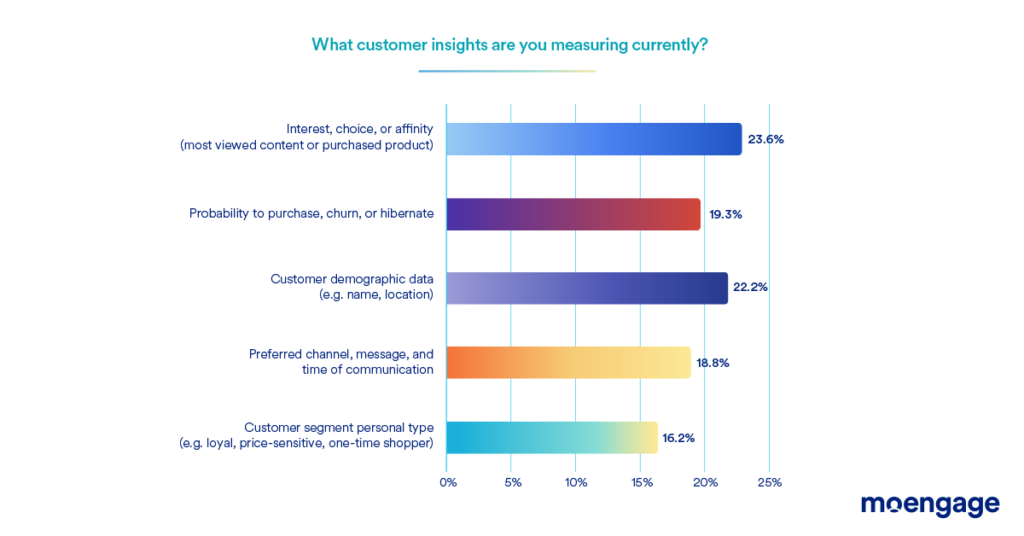
Even though these insights will provide a fair idea of what your customers prefer, these are not enough. It would be best if you also were observing insights such as customer persona type categories; preferred channel, message, or time of communication; and probability to purchase or churn. These together will offer a holistic view of how your customers are and what they might do next to design a personalized experience that delights and engages your customers.
Campaign-centric engagement using best-performing channels
That’s one of the many reasons why 32.1% of marketers run their engagement campaigns based on previous campaigns’ best-performing channels and time. But that is not the optimum approach. One of the best approaches is to consider customer behavior data to create segments, utilize multiple channels as a part of one customer journey, and send personalized communication. Our survey found that only 15% to 20% of marketers follow these strategies.
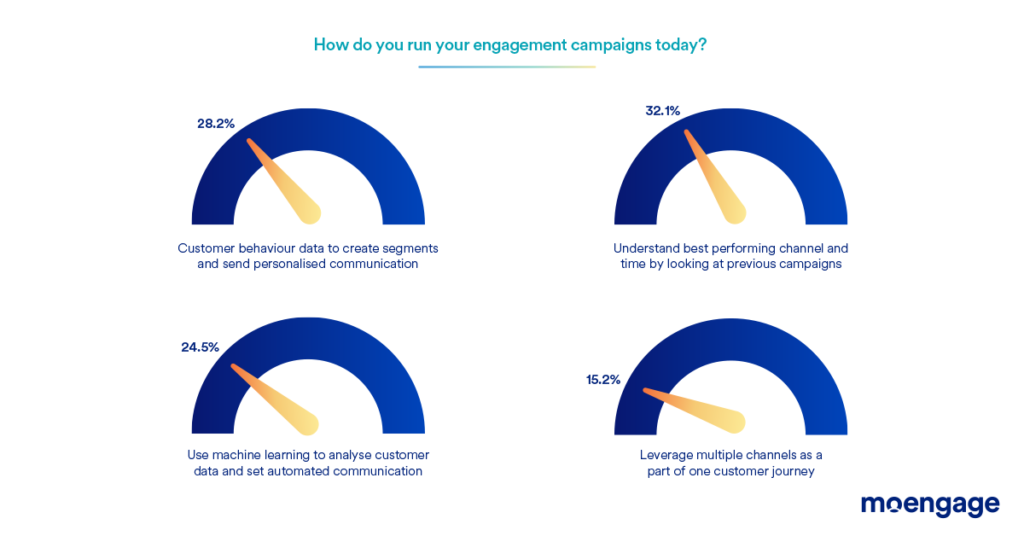
2.2 Insights on Journeys
Even though most preference is given to understanding customer preferences, behavior, and activity, it is equally crucial to understand their journey across channels. Some aspects like where your customer is most engaged or dropped off in the journey, their navigation on the app or website, and such acuities play a crucial role in personalized customer experiences.
Understanding the most optimum path to conversion takes priority
After examining our report findings for journey insights, we found that 40.8% of marketers prioritize the most optimum way to convert insight. The other two equally crucial insights, drop-off moments and AHA/delightful moments had around 29% of marketers advocating them.
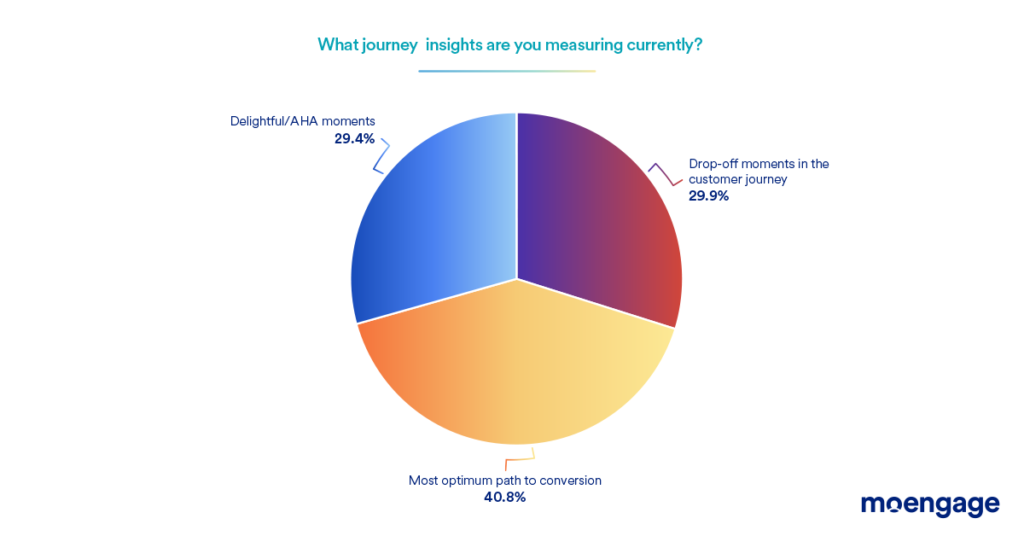
We understand the path to conversion can be one of the most important metrics as it allows us to predict business growth. However, knowing when your customers are dropping-off or which moment triggers their purchase decision can come in handy too.
Even if marketers are looking at conversion, they are still using digital channels to personalize communication and engage buyers.
The key reason to utilize digital channels is to send recommendations.
27.8% of marketers use channels such as social platforms and mobile apps to send personalized products or content recommendations. Social media platform usage is at its all-time high as more and more customers are moving toward such online channels, especially for its overall customer experience. Hence, even marketers are working towards creating a personalized, mobile-friendly customer experience.
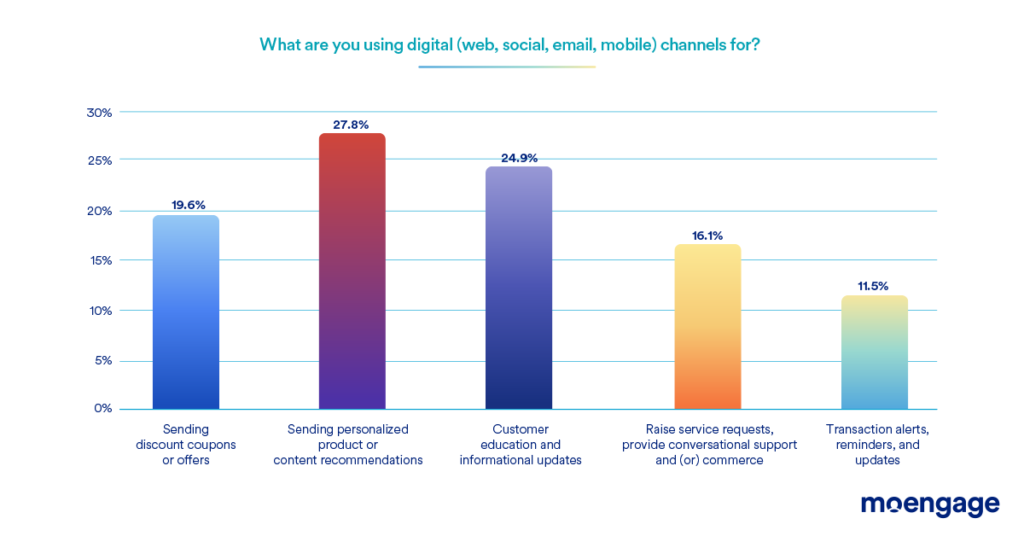
Around 24% of marketers also use these channels to share educative and informational updates and engage customers. However, effectively utilizing these channels to create an omnichannel experience will not happen unless you send transactional updates, offers and discounts, and customer support.
It all comes back to the same point/strategies — going beyond observing conversions’ paths regarding journey insights.
2.3 Insights on Campaigns
We know what marketers are learning more about their customers and the aspects of their journey they are monitoring. So what is the next thing to know? Understanding how customers engage and react to your campaigns and communications is essential. Also, what channels are being utilized to engage your customers, and what customer experience is being offered?
Emphasis on knowing engaging customer segments
Regarding how campaigns work, 39.1% of marketers prefer to look at the most engaging customer segments. But is that enough? Absolutely, no.
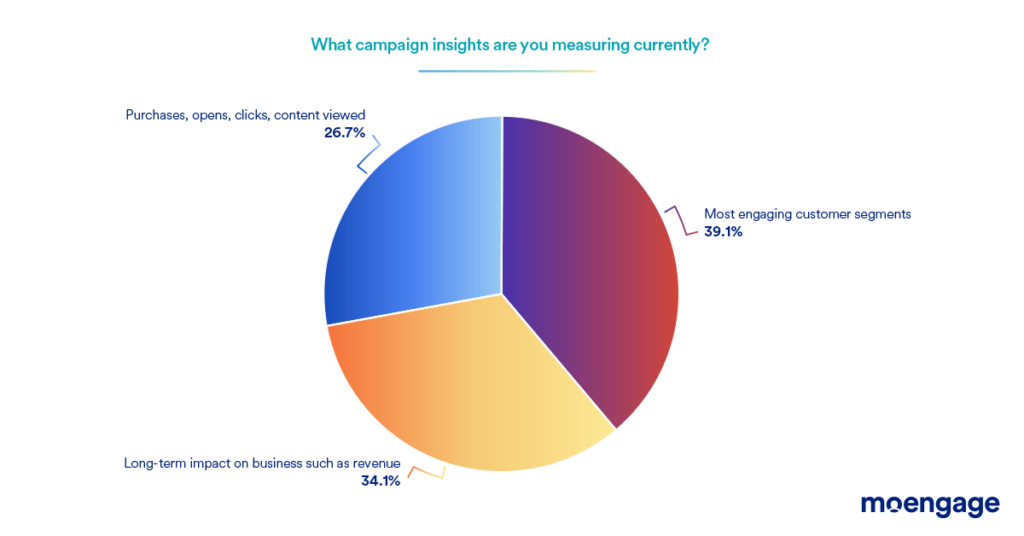
The number of purchases, opens, clicks, content viewed (26.8%), and long-time impact on business (34.1) should be emphasized equally. Marketers must create a comprehensive strategy based on these customer experience insights for effective omnichannel campaigns.
Let’s dive into the utilization and prioritization of different channels when running these campaigns and how each would affect how you engage your customers.
Email is the highest utilized engagement channel.
Email tops the list of channel utilization with 18.1%. Social messaging chat apps follow next with 15.1% and SMS with 13.1%. It is intriguing to see that channels such as Youtube Ads (9.1%), social media platforms (10.9%), and in-app messaging (10.6%) got the lowest votes when it comes to engaging your customers.
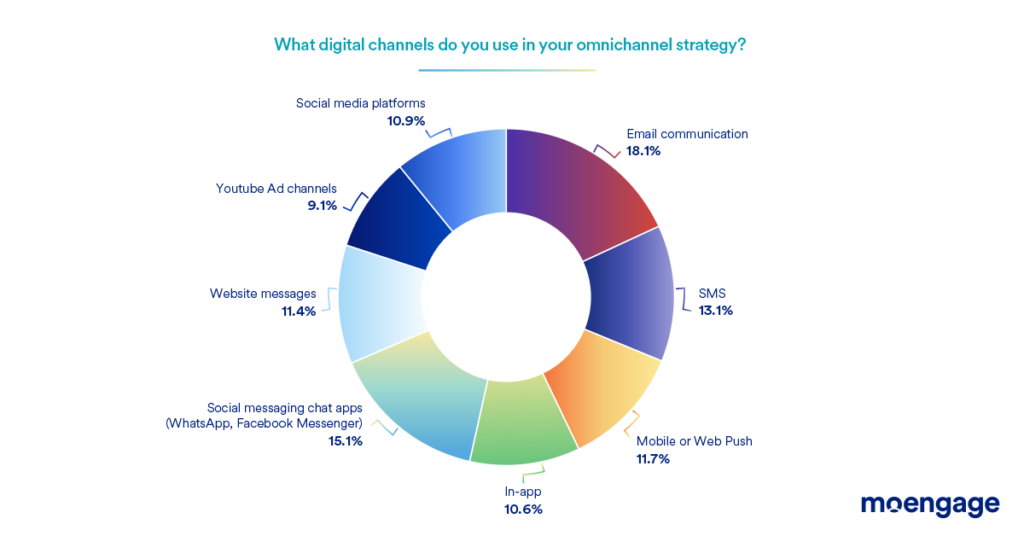
Customer opt-in data is used to prioritize channels.
37.3% of marketers prioritize channels for communication based on customer preferences (opt-in data). The compelling approach, i.e., using behavioral attributes to evaluate channel and time preferences, is only employed by 12.3% of marketers.
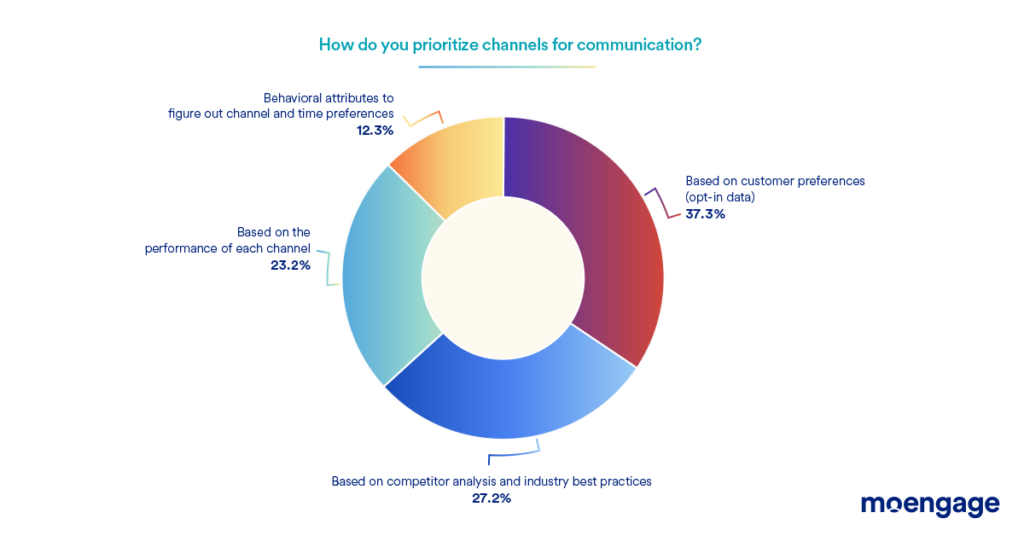
This discrepancy in channel utilization and prioritization can be because of the factors the marketers scrutinize regarding campaigns.
3. Impact of Insights on Business Growth
So we know what aspects of customer, journey, and campaign marketers scrutinize. The next factor in understanding is whether you think observing these insights (including the ones currently not getting observed) impacts the business.
So we asked our respondents to tell us if they feel analyzing the abovementioned three types of insights impacts their business metrics. And guess what?
3.1 Marketers Need Insights for Customer-centric Engagement
39.5% of marketers think knowing and monitoring these are impactful for their business. Even though 33.9% of marketers are on the fence about the impact, we feel one reason can be that they cannot monitor these insights easily.
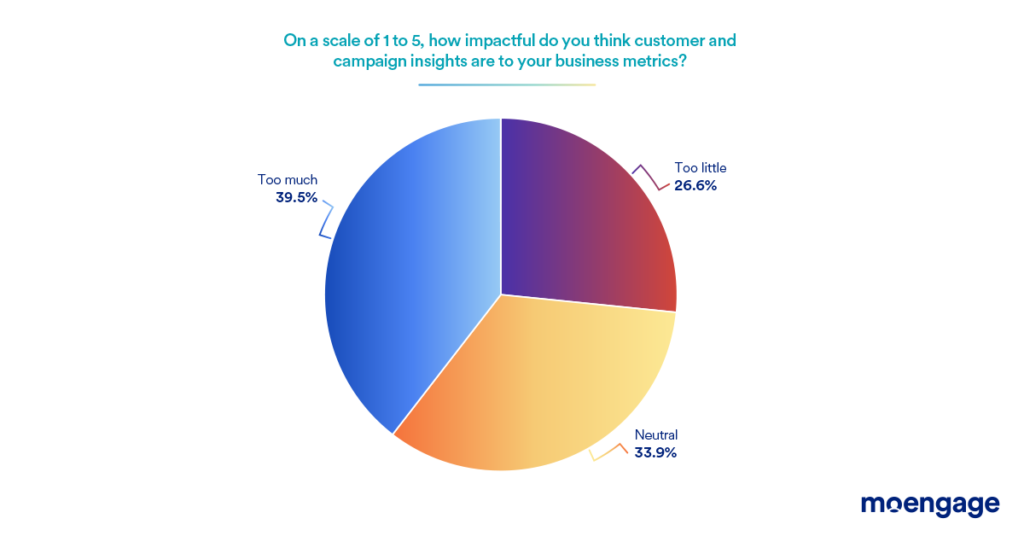
Looking at the data from an organizational size perspective, we observed that mid-market and enterprise brands feel these insights impact business growth and how customers engage with the brand. However, 34% of SMBs are neutral about the impact. The reason can be that the focus of SMB brands is on customer acquisition as they focus on growing their customer base and not on retention/engagement.
But the current tech stack is focused on campaign-centric engagement.
Overall, we know that marketers feel gathering and monitoring these insights can be greatly helpful. Digital-first and enterprise brands’ marketers discern that gathering more in-depth customer information can be crucial to overall business growth. However, they are not collecting them. The reason behind this can be anything, but we found that their current customer engagement tech stack is limited.
Insights Reveal the Unique Path to Customer Experience, But Are You Seeing?
Yes, having reliable data on your existing customers is a good strategy. But what’s even better is to have multiple insights that go deeper into their psyche. For any brand that’s pushing to create customer loyalty and customer satisfaction, you need to:
- understand the buyer’s journey and scrutinize past interactions;
- build a complete buyer journey to segment and create campaigns accordingly; and
- construct an omnichannel customer engagement strategy, including social media engagement.
However, all this and more is possible with insights as it will help you connect the missing dots (which otherwise data is not doing). With this customer engagement statistics report, we aim to help you, marketers across the globe, understand how crucial it is to know your customers on a deeper level. An accurate customer-centric approach must scrutinize customer and engagement data across different groups. We also commissioned regional reports to give marketers a regional perspective on customer engagement statistics.
Deep-dive Into Regional Customer Engagement Statistics
Find the Europe Edition of the same report here -> Get Europe Report Here
Find the India Edition of the same report here -> Get India Report Here
Find the North America Edition of the same report here -> COMING SOON!
Find the Middle East Edition of the same report here -> COMING SOON!
Find the Southeast Asia Edition of the same report here -> COMING SOON!















